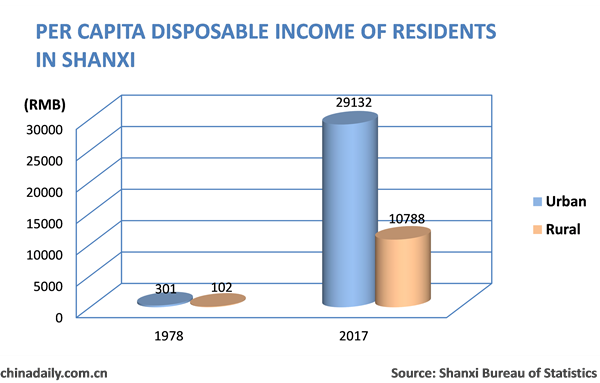
The per capita disposable income of urban residents in Shanxi province increased from 301 yuan ($43.36) in 1978 to 29,132 yuan in 2017, 96.7 times more than that of 1978. The per capita disposable income of rural residents increased from 102 yuan in 1978 to 10,788 yuan in 2017, 105.8 times more than that of 1978.
By the end of 2017, the per capita housing area of urban residents was 32.4 square meters, an increase of 25.8 sq m from the end of 1990; the per capita housing area of rural residents was 37.5 sq m, an increase of 21 sq m from the end of 1990.
The province has also seen huge rises in consumption. In the past 40 years, the consumption expenditure of urban residents in Shanxi has increased from 275 yuan in 1978 to 18,404 yuan in 2017, with an average annual increase of 11.4 percent; the consumption expenditure of rural residents increased from 91 yuan in 1978 to 8,424 yuan in 2017, with an average annual increase of 12.3 percent.
The consumption structure has undergone fundamental changes, from single household daily consumption to multi-level consumption such as consumption in culture, education, tourism, healthcare and housing. The Engel coefficient of urban residents dropped from 55.6 percent in 1978 to 23.1 percent in 2017; the Engel coefficient of rural residents decreased from 67 percent in 1978 to 27.4 percent in 2017.
Residents of the province have seen a significant improvement in their ability to access healthcare. There were 13,549 medical institutions in the province in 2017, an increase of 8,554 over 1978. The average number of physicians per 10,000 people increased from 14.51 in 1978 to 24.9 in 2016, an increase of 71.6 percentage points.
In terms of education, Shanxi has made four decades of reform to its education system, with a particular emphasis on basic education. The enrollment rate of primary school-age children has reached 99.9 percent. In 2017, Shanxi renovated and expanded 1,355 kindergartens and added six universities and three vocational schools. From 2013 to 2017, 34,000 graduate students, 948,000 university and college students, and 691,000 vocational school students were trained, and 15 million people attended public technical and vocational training.
The social security system has also seen improvements. In 2017, there were 6,068 community service facilities in cities and towns, an increase of 4,676 compared with that of 2000, and 648 comprehensive community service centers, an increase of 605 over that of 2000. More people were covered by social security insurance. And in 2017, the number of people with medical insurance and unemployment insurance increased by 30.59 million and 1.35 million respectively compared with that of 2001; the number of people receiving urban minimum living allowances was 531,000, an increase of 175,000 over 2001.
The jobs market in Shanxi has also improved over the past 40 years. In 2017, 191.41 million people were employed, 9.49 million more than in 1978, with an average annual increase of 243,300. The proportion of employed persons in the permanent population increased from 39.83 percent to 51.7 percent between 1978 and 2017. The unemployment rate has remained low, with the unemployment rate over the past five years stable at around 3 percent. The minimum wage increased from 120 yuan in 1995 to 1,400 yuan in 2017.